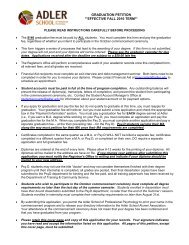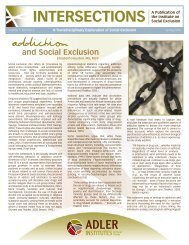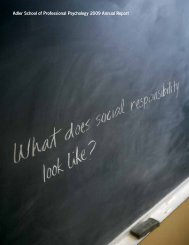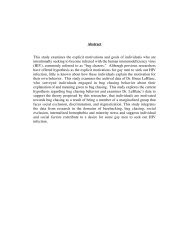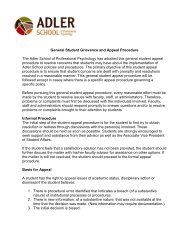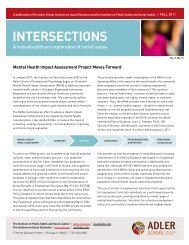Using Simulations to Promote Social Justice in Clinical Practice
Using Simulations to Promote Social Justice in Clinical Practice
Using Simulations to Promote Social Justice in Clinical Practice
- No tags were found...
Create successful ePaper yourself
Turn your PDF publications into a flip-book with our unique Google optimized e-Paper software.
Individual/InternalSystemic/Structural/ExternalMedical ModelBiopsychosocial model
1. People have poor health because they’ve made unhealthychoices. It’s a question of <strong>in</strong>dividual responsibility.2.Problems lie <strong>in</strong> personal <strong>in</strong>adequacies and remedies liebeyond personal power. (Roy, 2007).3. Health disparities (<strong>to</strong> the extent they are acknowledged)may be unfortunate but not necessarily unfair.4. There’s little that can be done.(Unnatural Causes <strong>to</strong>ol kit)
InternalExternal*--------------------------------------------------------*IndividualSystemicChoiceBiologyEnvironmentPolicy
PsychoanalyticAdlerianExistentialPerson-CenteredGestaltBehaviorPostmodernFamily SystemsRealityFem<strong>in</strong>istsCognitiveBehavioral
AgencyExam<strong>in</strong><strong>in</strong>g the relationship betweenconditions outside the body and healthGroup therapy and empowerment (Roy,2007)• Problem solv<strong>in</strong>g groups• Community support, skill learn<strong>in</strong>g unlearn<strong>in</strong>gpowerlessness-learn<strong>in</strong>g power shar<strong>in</strong>g
(Comas-Diaz, 2007)
Common f<strong>in</strong>d<strong>in</strong>gs (systemic and personal)• Public hous<strong>in</strong>g (overcrowded, unhealthy liv<strong>in</strong>gconditions)• Substandard schools• Limited health care• Victim of sexual abuse (rape, molestation)• Sex workers• Addicted <strong>to</strong> multiple substances (alcohol and coca<strong>in</strong>e)• Familial loss (gang violence, poor health)• Health problems(asthma, hypertension, hepatitis)• General his<strong>to</strong>ry of multiple traumas• Separated from children and partners
List 5 important issues that may h<strong>in</strong>derL<strong>in</strong>da’s successful treatment andre<strong>in</strong>tegration back <strong>in</strong><strong>to</strong> society.What issues will most impact your plan oftreatment?What other important <strong>in</strong>formation mightyou ask for?
STRUCTURAL CONCERNSINDIVIDUAL CONCERNS(MENTAL AND PHYSICAL)No health <strong>in</strong>suranceTransportationFoodHous<strong>in</strong>g issues• Lived near fac<strong>to</strong>ry• Multiple residents <strong>in</strong> smallliv<strong>in</strong>g quarters• Poor structural featuresAccess <strong>to</strong> (mental) health care• Wait<strong>in</strong>g time forPsychiatristsEmployment• FELONY CHARGE• LIMITED EDUCATION Previous drug use Experience of trauma Death of loved one Familial issues Development issues Anxiety Asthma
Majorityof herneeds
CognitiveEmotional IntelligenceExperientialHow it applies <strong>to</strong> the simulationHow it has <strong>in</strong>formed my work with theladies from Grace House
My experience at Grace House
PAI trends• Negative Self Images, Warm, Depression, Stress,Anxiety TAT trends• Personally identifies with several cards. Mentionssystems and <strong>in</strong>stitutions (poor hous<strong>in</strong>g, jails,hospitals) Early Memories• Also mentions poor and overcrowded hous<strong>in</strong>g Intelligence Tests• Higher scores on novel tasks, lower scores on verbaltasks
Warm and engag<strong>in</strong>gResilientAdaptiveStrong social skills
Video Clips
Angus, L., & Kagan, F. (2007). Empathic relational bonds and personal agency <strong>in</strong> psychotherapy: Implications forpsychotherapy supervision, practice, and research. Psychotherapy: Theory, Research, <strong>Practice</strong>, Tra<strong>in</strong><strong>in</strong>g 44(4),371–377.Bronfenbrenner, U. (1979). The ecology of human development: Experiments by nature and design. Cambridge, MA:Harvard University Press.California News Real. (2007). Unnatural causes: Action <strong>to</strong>ol kit. Retrieved Oc<strong>to</strong>ber 22, 2008 from Unnatural CausesWeb site: http://www.unnaturalcauses.org/assets/uploads/file/UC_Toolkit_4_Plann<strong>in</strong>g.pdfComas-Diaz, L. (2007). Ethnopolitical psychology: Heal<strong>in</strong>g and transformation. In Aldarondo, E. (Ed.), Advanc<strong>in</strong>gsocial justice through cl<strong>in</strong>ical practice (pp. 91-118). Mahwah, NJ: Lawrence Erlbaum Associates, Publishers
Adelman, L. (Executive Direc<strong>to</strong>r) (2003). Race: The power of Illusion. Hollywood, CA; California Newsreel.Albee, G. W. (1986). Toward a just society: Lessons from observations on the primary prevention ofpsychopathology. American Psychologist, 41(8), 891-898.Aldarondo, E. (2007). Rek<strong>in</strong>dl<strong>in</strong>g the reformist spirit <strong>in</strong> the mental health professions. In Aldarondo, E. (Ed.),Advanc<strong>in</strong>g social justice through cl<strong>in</strong>ical practice (pp. 3-18).Mahwah, NJ: Lawrence Erlbaum Associates,Publishers.Christens, B., & Perk<strong>in</strong>s, D.D. (2008). Transdiscipl<strong>in</strong>ary, multilevel action research <strong>to</strong> enhance ecological andpsycho-political validity. Journal of Community Psychology,36(2), 261-268.Dreikurs, R. R. (1971). <strong>Social</strong> equality: The challenge of <strong>to</strong>day. Chicago, IL: The Adler School of ProfessionalPsychology.Fairfax, D. (2000). From data raider <strong>to</strong> democratic researcher: Learn<strong>in</strong>g <strong>to</strong> become an academic-activist with theMerrimack Valley Project. In Sherman, F. T., & Torbert, W. R. (Eds.), Transform<strong>in</strong>g social <strong>in</strong>quiry transform<strong>in</strong>gsocial action (pp. 11-36). Norwell, MA: Kluwer.Feag<strong>in</strong>, J. (2001). <strong>Social</strong> justice and sociology: Agendas for the twenty-first century. American Sociological Review,66, 1-20.Fondacara, M. R., & We<strong>in</strong>berg, D. (2002). Concepts of social justice <strong>in</strong> community psychology: Toward a socialecological epistemology. American Journal of Community Psychology, 30(4), 473-492.Freire, P. (2000). Pedagogy of the oppressed. New York, NY: Cont<strong>in</strong>uum International Publish<strong>in</strong>g Group.Gantt, E. E., & Williams, R. N. (2002). Seek<strong>in</strong>g social grounds for social psychology. Theory & Science, 1-15.Goodman, L.A., Liang, B., Helms, J. E. Latta, R.E., Sparks, E., & We<strong>in</strong>traub, S.R. (2004). Tra<strong>in</strong><strong>in</strong>g counsel<strong>in</strong>gpsychologists as social justice agents: Fem<strong>in</strong>ist and multicultural pr<strong>in</strong>ciples <strong>in</strong> action. The Counsel<strong>in</strong>gPsychologist, 32, 793-837.Helms, J. E. (2003). A pragmatic view of social justice. The Counsel<strong>in</strong>g Psychologist, 31(3), 305-313.Jackson, J. (2000). What ought psychology <strong>to</strong> do? American Psychologist, 55(3), 328-330.K<strong>in</strong>g, M. L., Jr. (1968). The role of the behavioral scientist <strong>in</strong> the CivilRights Movement. Journal of <strong>Social</strong> Issues, 24(1), 1-12.Lerner, R. M. (2000). Transform<strong>in</strong>g universities <strong>to</strong> susta<strong>in</strong> outreach scholarship: A communiqué from the front. InSherman, F. T., & Torbert, W. R. (Eds.), Transform<strong>in</strong>g social <strong>in</strong>quiry, transform<strong>in</strong>g social action (pp. 37-56),Norwell, MA: Kluwer.McWhirter, B. T., & McWhirter, E. H. (2007). Toward an emancipa<strong>to</strong>ry communitarian approach <strong>to</strong> the practice ofpsychology tra<strong>in</strong><strong>in</strong>g. In Aldarondo, E. (Ed.), Advanc<strong>in</strong>g social justice through cl<strong>in</strong>ical practice (pp. 391-416).Mahwah, NJ: Lawrence Erlbaum Associates, Publishers.Meyers, S. A. (2007). Putt<strong>in</strong>g social justice <strong>in</strong><strong>to</strong> practice <strong>in</strong> psychology courses. Observer, 20(9).
Miller, G. A. (1969). Psychology as a means of promot<strong>in</strong>g human welfare. American Psychologist, 24, 1063-1075.National Coalition on Health Care (2008). Facts about health <strong>in</strong>surance coverage. Retrieved Oc<strong>to</strong>ber 7, 2008 from National Coalition onHealth Care Website: http://www.nchc.org/facts/coverage_fact_sheet_2007.pdf.Patterson, C. H. (1969). The social responsibility of Psychology. Paper presented at 77 th annual convention, American PsychologicalAssociation: Wash<strong>in</strong>g<strong>to</strong>n, D.C.Prilleltensky, I. (1989). Psychology and the status quo. American Psychologist, 44(5), 795-802.Prilleltensky, I. (1994). The morals and politics of psychology: Psychological discourse and the status quo. Albany, NY: State University ofNew York Press.Prilleltensky, I. (2001). Value based praxis <strong>in</strong> community psychology: Mov<strong>in</strong>g <strong>to</strong>ward social justice and social action. American Journal ofCommunity Psychology, 29(5), 747-781.Prilleltensky, I., Dokecki, P, Frieden, G, & Ota Wang, V. (2007). Counsel<strong>in</strong>g for wellness and justice: Foundations and ethical dilemmas. InAldarondo, E. (Ed.), Advanc<strong>in</strong>g social justice through cl<strong>in</strong>ical practice (pp. 19-42). Mahwah, NJ: Lawrence Erlbaum Associates,Publishers.Rawls, J. (1971). A theory of justice. Cambridge, MA: Belknap press of Harvard University Press.Reeser, L. C. (2007). Educat<strong>in</strong>g for social change <strong>in</strong> the human service professions. In Aldarondo, E. (Ed.), Advanc<strong>in</strong>g social justice throughcl<strong>in</strong>ical practice (pp. 459-474). Mahwah, NJ: Lawrence Erlbaum Associates, Publishers.Rogers, A., & Pilgrim, D. (2003). Mental health and <strong>in</strong>equality. New York, NY: Palgrave Macmillan.Roy, E. (2007). Radical psychiatry. In Aldarondo, E. (Ed.), Advanc<strong>in</strong>g social justice through cl<strong>in</strong>ical practice (pp. 65-90). Mahwah, NJ:Lawrence Erlbaum Associates, Publishers.Sapp, D. A. (2003). Challenges <strong>in</strong> promot<strong>in</strong>g social justice <strong>in</strong> the undergraduate composition classroom. NY, NY: ERIC. Retrieved Oc<strong>to</strong>ber15, 2008 from: http://www.library.uiuc.edu/rex/<strong>in</strong>struction/eric.htm. ED 474 967.Smedly, B., Jeffries, M., Adelman, L., & Cheng, J. (2007). Race, racial <strong>in</strong>equality and health <strong>in</strong>equalities: Separat<strong>in</strong>g myth from fact.United States Department of Health and Human Services. (2007). Public health promotion and protection, disease prevention, andemergency preparedness. Retrieved Oc<strong>to</strong>ber 17, 2008 from: http://aspe.hhs.gov/hhsplan/2007/hhsplanpdf/hhsplanc3.pdf.Vera, E. M., & Speight, S. L. (2003). Multicultural competence, social justice, and counsel<strong>in</strong>g psychology: Expand<strong>in</strong>g our roles. TheCounsel<strong>in</strong>g Psychologist, 31(3), 253-272.




